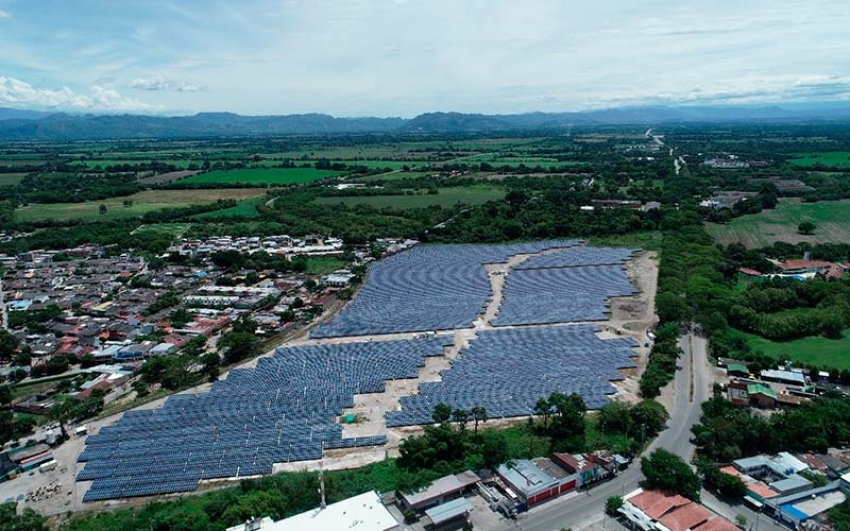EL MOMENTO DE LA SOLAR FOTOVOLATICA
- 10 de septiembre de 2020
[tp lang=»es» not_in=»en»]
Fuente: http://www.mundoelectrico.com/index.php/component/k2/item/775-el-momento-de-la-solar-fotovoltaica#

Desde que se han tomado conciencia sobre el problema que genera el cambio climático, las autoridades han impulsado la búsqueda de fuentes de generación de energía que no emitan gases de efecto invernadero. De este modo se pretende evitar que la expansión del sistema de generación eléctrica, para abastecer a una demanda creciente, se haga con base en centrales que funcionen con combustibles fósiles o grandes centrales hidroeléctricas.
Ambas son formas de producción, que han demostrado ser económicamente rentables y confiables pero que emiten CO2, para el caso de la utilización de combustibles fósiles, o gas metano, en el caso de las grandes centrales hidroeléctricas de embalses. Ambos gases, tienen una importante contribución al efecto invernadero, que provoca el cambio climático.
A lo largo de esta búsqueda de nuevas fuentes de generación hay dos tecnologías que se destacan por su confiabilidad y economía: la eólica y la solar. Ambas fuentes presentan una emisión muy escasa durante su proceso de implantación, y casi ninguna emisión durante su ciclo de operación. Además, dependen de fuentes inagotables y autóctonas. Tienen una producción anual casi constante, que es independiente de los fenómenos meteorológicos, lo cual asegura estabilidad de precios. La madurez tecnológica de ambas fuentes ha permitido que compitan de igual a igual con la generación clásica, aún sin considerar los beneficios ambientales en lo que se refiere a costos y confiabilidad.
Vale aclarar que ambas fuentes son variables y no gestionables, lo cual dificulta el despacho centralizado. Sin embargo, y más allá de que esta característica pudiera resultar inconveniente, sus efectos se ven disminuidos cuando las integramos en sistemas que, como el colombiano, tienen un importante componente se generación hidroeléctrica flexible que facilita la integración al sistema eléctrico.
Por las características topográficas de Colombia, la energía eólica queda confinada a determinadas zonas del país, donde existe un enorme potencial de generación. Por el contrario, una de las características sobresalientes de la energía solar es que más allá de que se trate de microgeneración (de unos pocos kW) o mega generación (de cientos de MW) siempre se adaptan a distintas características topográficas o incluso urbanas, para su implementación. Esto se debe a que una mega generación solar se compone de la suma de muchas microcentrales, lo cual le da gran versatilidad en su montaje.
Más allá de las coincidencias constitutivas que tienen las distintas centrales fotovoltaicas (debido a su tamaño), estas apuntan a mercados distintos. Las megacentrales apuntan al mercado mayorista buscando presentar precios competitivos. Por ello, el esfuerzo en el diseño de estas plantas debe ser muy cuidadoso buscando la mayor eficiencia posible en la conversión del recurso solar en energía eléctrica.
Por su parte, la micro generación compite en el mercado minorista, donde los precios son más elevados, permitiendo adaptar la topología de estas micro plantas a las instalaciones preexistentes. Por ello, suelen adaptarse a las formas de edificios, bodegas o cobertizos de estacionamiento.
En Ventus tenemos las capacidades y el conocimiento necesario para el desarrollo de ambos tipos de centrales. De hecho, en sus 10 años de operaciones, la empresa ha construido 16 plantes solar para microgeneración, y 8 megacentrales, entre las que se incluyen cuatro (4) en Colombia.
La característica del sistema eléctrico colombiano que tienen un fuerte componente hidroeléctrico flexible, la calidad del recurso solar, la relativa estabilidad de precios de bolsa que facilita la paridad horaria de estas centrales no gestionables, así como los beneficios fiscales establecidos en Ley 1715: auguran para Colombia un gran potencial de penetración de energía solar.
[/tp]
[tp lang=»en» not_in=»es»]
Source: http://www.mundoelectrico.com/index.php/component/k2/item/775-el-momento-de-la-solar-fotovoltaica#

Since they rise of the awareness of the problem caused by climate change, the authorities have promoted the search for sources of energy generation that do not emit greenhouse gases. This intends to prevent the expansion of the electricity generation system, to supply a growing demand, which has been based on plants that run on fossil fuels or large hydroelectric plants.
Both are sources of energy production, which have proven to be economically profitable and reliable, but that emit CO2, in the case of the use of fossil fuels, or methane, in the case of large hydroelectric reservoir plants. Both, CO2 or methane, have a great impact on the greenhouse effect, which causes climate change.
Throughout this search for new generation sources, there are two technologies that stand out for their reliability and economy: wind and solar energy. Both sources present a very low emission during their implementation process, and almost no emissions during their operating cycle. In addition, they depend on inexhaustible and indigenous sources. They have an almost constant annual production, which is independent of the meteorological phenomena, which ensures price stability. The technological maturity of both sources has allowed them to compete equally with the classic generation, even without considering the environmental benefits in terms of costs and reliability.
It is worth clarifying that both sources are variable and unmanageable, which makes centralized dispatch difficult. However, and beyond the fact that this characteristic could be inconvenient, its effects are diminished when we integrate them into an electric system that, like the Colombian one, has an important flexible hydroelectric generation component that facilitates integration into the electrical system.
Due to the topographic characteristics of Colombia, wind energy is confined to certain areas of the country, where there is an enormous generation potential. On the contrary, one of the outstanding characteristics of solar energy is that regardless of whether it is microgeneration (of a few kW) or mega generation (of hundreds of MW), they always adapt to different topographic or even urban characteristics, to its implementation. This is due to the fact that mega solar generation is composed by a sum of many micro-power plants, which gives it great versatility in its assembly.
Beyond the constitutive coincidences that the different solar farms have (due to their size), they point to different markets. Megacentrales target the wholesale market seeking to present competitive prices. Therefore, the effort in the design of these plants must be very careful looking for the highest possible efficiency in the conversion of the solar resource into electrical energy.
On the other hand, micro-generation competes in the retail market, where prices are higher, allowing the topology of these micro-plants to be adapted to pre-existing facilities. For this reason, they are often adapted to the shapes of buildings, warehouses or parking sheds.
At Ventus we have the necessary experience and knowledge to develop both types of power plants. In fact, in its 10 years of operations, the company has built 16 solar plants for microgeneration, and 8 mega-power plants, including four (4) in Colombia.
Colombian electricity system characterizes for having a strong flexible hydroelectric component, the quality of the solar resource, the relative stability of stock prices that facilitates the hourly parity of these non-manageable plants, as well as the tax benefits established in Law 1715: they augur for Colombia has a great potential for solar energy penetration.
[/tp]




